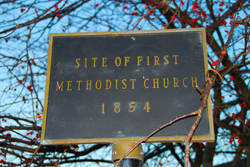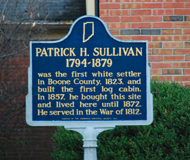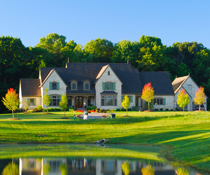 |
|
The Village Heritage
The story of Zionsville is a story of success. Success has been realized because of careful planning, responsible citizenry and caring neighbors. And, although those attributes appear to be describing the town of today, they are equally appropriate to any period in its 150 year history. The entire community celebrated the town’s sesquicentennial in a variety of ways during 2002.

In the early 1820’s, as settlers pushed northward in the fledgling state of Indiana, sturdy pioneers seeking land where they could put down roots followed the waterways and trails into the Eagle Creek valley. Some, like Patrick Henry Sullivan, the first permanent white settler in the area that is now Zionsville, settled near the creek. Others, like David Hoover, chose land on higher ground erecting a cabin near the present south-east corner of Oak and Sixth streets.

With the election of Hoover as first clerk of the Boone County probate court in April 1830 and as county recorder that August, early sessions of the court were held in his cabin. The cabin also served as a polling place in the August election and regularly was the site of church services and other gatherings. The first marriage license issued by Hoover’s office was to his daughter Mary “Polly” Hoover and Elijah Cross who were wed in her family’s cabin on January 13, 1831.

When Hoover, then a resident of Lebanon, died four years later Elijah and Mary Cross came into possession of the 80-acre homestead. By 1850 they had acquired considerable additional acreage. At that time, Eagle Village was a thriving community on the Michigan Road, a stagecoach route about a mile east of the Cross land.

In 1849 promoter of a railroad between Indianapolis and Lafayette were busy encouraging the organization of towns along the intended route. One of those promoters was William Zion, a Lebanon businessman who was a member of the Board of Directors of the proposed railway. Zion had founded Hazelrigg Station northwest of Lebanon; and with Whitestown established in 1851, he saw the need for another station between Whitestown and the Boone-Marion county line and about halfway between Lebanon and Indianapolis.
Zion convinced Elijah and Polly Cross that a town should be built on their Eagle Township land. The Crosses agreed and Elijah and William Zion became partners as proprietors in the venture. Once they decided on its location, County Surveyor James Mullikin surveyed the site and drew up the Original Plan, dating his report and a chart of the layout on November 5, 1851. It was January 26, 1852 when the proprietors filed the report and chart with Boone County Recorder Thomas P. Miller.

In choosing a name for the town-to-be, Elijah Cross asked his wife to consent that the town be named Marysville in her honor. When she declined, he decided to extend that honor to his partner, William Zion. Zion neither owned any of the land to be developed, nor did he ever live in Zionsville.
The Crosses were not the only ones who saw the potential of a community that would be served by the railroad. Not only could goods be shipped much faster, the “Iron Horse” was capable of moving a much larger quantity than any previous form of transportation. Residents, merchants and tradespeople hastily moved to the new community, often bringing their houses or shops with them.
John Miller built the first house in Zionsville, probably early in 1852, on Lot 2, Block 8 in the Original Plat. The Miller family lived in the house, and also took in boarders. Vaughn was commissioned postmaster on September 3, 1853, the same year the railroad was completed through town on what is now First Street.

In 1854, the Methodist Church moved from Eagle Village to Zionsville, building a sanctuary at what is now the southeast corner of Poplar and Main streets. It was followed in 1858 by the Christian Church which was dismantled at Eagle Village and rebuilt on the northeast corner of the present Hawthorne and Second streets.
The first schoolhouse in the village was erected in 1854, across the street and north of the Methodist Church. It was a two-story clapboard structure with one room on each floor. By 1856, the community was served by a number of business, a saw mill and a grist mill.
A.G. Abbott began publication, in 1860, of a local newspaper that has been in continuous publications ever since. Today the Zionsville Times Sentinel is the oldest publication with that distinction in the county.

In 1861, when President-elect Abraham Lincoln’s train passed through Zionsville carrying him from his home in Illinois to his inauguration, it stopped briefly at Zionsville. Mr. Lincoln stepped onto the bunting-draped rear platform of the train and spoke briefly to the assembled crowd. The site was later commemorated in his honor as Lincoln Park.
The town continued to grow, with the census of 1860 showing a population of 364. Ten years later the count was 956. The Zionsville Times, in 1884, published the names of 84 shopkeepers, tradesmen and professionals with businesses in the area.
A new brick schoolhouse, known as “The Academy”, was built on Walnut Hill in 1868, site today of the Hussey-Mayfield Memorial Public Library. The two-story structure housed the lower grades in four classrooms on the first floor, with classes for a three-year high school conducted on the second floor. The first class to complete a four-year high school education was graduated in 1888.

Zionsville’s reputation as a cultural center began in the late 19 th century when businessman B.F. Clark opened a hall with a stage over his Main Street store where noted orators and entertainers appeared and home talent performances were held. Among those who graced the stage of Clark’s Opera House, as it was called, were nationally prominent suffragists Susan B. Anthony and Elizabeth Cady Stanton, and noted Hoosier poet James Whitcomb Riley.
An outdoor venue for entertainment and education opened in 1891 as Zion Park, managed by a group of local shareholders. Each summer, for a period of two weeks and three weekends, Chautauqua-like gatherings, known as the Zion Park Assembly, were held in the park’s large “Tabernacle”. The annual event drew thousands to the community. They came by train, wagon, buggy, horseback and on foot.
Zion Park was located on the wooded acreage where Eagle Lower Elementary stands today. It included a lake, Lake Como, where pleasure boats were available, and a baseball diamond, encouraging many outings during the spring, summer and fall.
In 1903, the Northwestern Division of the T.H.I. & E. interurban line began operating its passenger service on an hourly basis between Indianapolis and Lafayette. The track was located in the middle of Zionsville’s Main Street, and held special appeal for commuters seeking a rapid ride. The interurban station stood where The Village Clock Shop is today. The line discontinued operation on October 31, 1930.
The Big Four Railroad relocated its tracks to the west of town in 1921. It is that rail bed that now forms the Parks Department’s Nancy Burton Memorial Trail.
The dahlia became the talk of the town in the late 1920’s, with friends meeting on street corners and boasting about the breadth of the latest blossom in their gardens. Zionsville had two professional dahlia growers, the Tudor Gardens of Jennie and Adah Tudor and Parkway Gardens of Fred Gresh. Both produced prize winning blossoms that drew admirers to the community and won prizes wherever they were exhibited. In 1933, Gresh received the Gold Medal from the American Dahlia Society at the Chicago World’s Fair for the outstanding flower of the year that he christened Zions’s pride.
Promoter of the community, such as the newly organized Lions Club which advertised the town’s advantages in the Indianapolis newspapers in 1931, liked to refer to the town as “The Dahlia City”.
As the years have flown by, Zionsville has continued to add amenities. Among them are cultural facilities such as the P.H. Sullivan Museum, founded in 1973; Munce Art Center, opened in 1981; and a new and improved library, dedicated as the Hussey-Mayfield Memorial Public Library in 1994.
Also churches of many denominations are within the town limits; service clubs abound, as do those whose emphasis is on study and/or camaraderie.
A strong business community, led by a vibrant Chamber of Commerce; a well-run town government; excellent schools; ample athletic facilities and an outstanding park system all continue to make Zionsville a community worth of a visit…or a lifetime.
By Joan P. Lyons
Lyons writes the weekly Past Times column that appears in the Times Sentinel. She co-edited the oral history, Zionsville: the first One Hundred Years, in 1988 and has written Rails to Trails: 150 years of Zionsville History. The above research has been validated by Boone County Historian Marianne Doyle, genealotist and researcher at the P.H. Sullivan Museum
Learn more about Zionsville's history by visiting the Sullivan Museum and Munce Arts Center Web site.
For more information contact:
The Greater Zionsville Chamber of Commerce
135 South Elm Street, Zionsville IN 46077
317-873-3836























